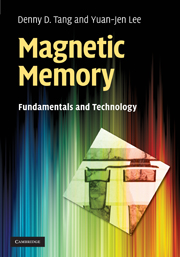Book contents
- Frontmatter
- Contents
- Preface
- Acknowledgments
- 1 Basic electromagnetism
- 2 Magnetic films
- 3 Properties of patterned ferromagnetic films
- 4 Magnetoresistance effects
- 5 Field-write mode MRAMs
- 6 Spin-torque-transfer mode MRAM
- 7 Applications of MTJ-based technology
- Appendix A Unit conversion table for cgs and SI units
- Appendix B Dimensions of units of magnetism
- Appendix C Physical constants
- Appendix D Gaussian distribution and quantile plots
- Appendix E Weibull distribution
- Appendix F Time-dependent dielectric breakdown (TDDB) of magnetic tunnel junction devices
- Appendix G Binomial distribution and Poisson distribution
- Appendix H Defect density and the breakdown/TMR distribution of MTJ devices
- Appendix I Fe, Ni and Co material parameters
- Appendix J Soft error, hard fail and design margin
- Index
Preface
Published online by Cambridge University Press: 06 July 2010
- Frontmatter
- Contents
- Preface
- Acknowledgments
- 1 Basic electromagnetism
- 2 Magnetic films
- 3 Properties of patterned ferromagnetic films
- 4 Magnetoresistance effects
- 5 Field-write mode MRAMs
- 6 Spin-torque-transfer mode MRAM
- 7 Applications of MTJ-based technology
- Appendix A Unit conversion table for cgs and SI units
- Appendix B Dimensions of units of magnetism
- Appendix C Physical constants
- Appendix D Gaussian distribution and quantile plots
- Appendix E Weibull distribution
- Appendix F Time-dependent dielectric breakdown (TDDB) of magnetic tunnel junction devices
- Appendix G Binomial distribution and Poisson distribution
- Appendix H Defect density and the breakdown/TMR distribution of MTJ devices
- Appendix I Fe, Ni and Co material parameters
- Appendix J Soft error, hard fail and design margin
- Index
Summary
The advent of semiconductor technology has impacted the lives of many of us since the 1970s. Silicon CMOS (complementary metal-oxide-semiconductor) devices are practically ubiquitous, and by the year 2000, the value of the semiconductor industry exceeded that of the automobile industry. The magnetic industry, on the other hand, is much smaller than the semiconductor industry. Engineering schools of universities rarely cover any courses in this discipline. Nonetheless, a tiny magnetic recording device is in the hard disk of every computer. Like CMOS devices, magnetic recording technology is being scaled down from generation to generation. At the time of writing, the physical size of the magnetic bit remains smaller than a DRAM bit on silicon chips.
Researchers working in these two communities had little in common until the development of the modern magnetic random access memory, or MRAM. A MRAM chip is built by integrating magnetic tunneling junction (MTJ) devices onto the silicon CMOS circuits. The research activity of MTJs in academia and industry, both hard disk and semiconductor, has been very active since it first showed signs of technology implication in the mid 1990s. That effort led to the mass production of the MTJ recording head in hard disk in 2006. In the same year, the semiconductor industry announced the first successful introduction of an MTJ memory product. The viability of MTJ technology is proven. It is expected that research activities will develop further, which will increase cooperation between these two research communities.
- Type
- Chapter
- Information
- Magnetic MemoryFundamentals and Technology, pp. ix - xPublisher: Cambridge University PressPrint publication year: 2010

